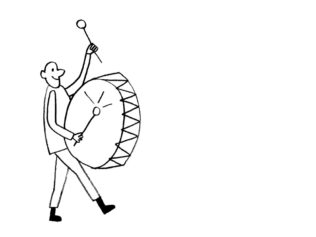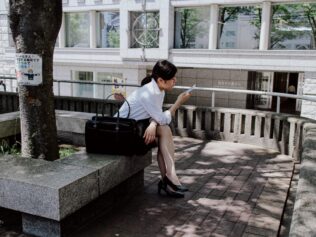
He believed everything to be connected and part of a greater unity. Perhaps there was something that made him so sure of that.
In the summer of 1973, philosopher Ervin László had become tired. The great thinker had just completed another global UN project and, despite invitations from prestigious universities, he chose a ruined chapel overgrown with tall grass. His intuition—which had saved his life and led him to discoveries many times before—suggested it was a good place for a year of rest. That year has stretched into almost half a century now, and László’s Tuscan house has become the perfect place for deepening his subtle relationship with the universe.
The beginning was bright and happy. He was given the name Ervin because of how original it was. No one in the family of the boy’s father—a Hungarian shoe manufacturer—had one like it. The year was 1933, business was thriving. Ervin grew up in a spacious apartment in Budapest, overlooking the park and the city’s spectacular architecture. He loved music. His mother was his first piano teacher. Ervin wasn’t good at reading sheet music—and it would stay that way—but when he played, it was as if he breathed the music; like he was in a different world. Beethoven’s Appassionata by Wilhelm Backhaus was his favorite. He played it over and over again, as it transported him to a land of unknown wonders. Viewing music as a vehicle into a different dimension is apt in the context of László’s biography—because just one trajectory of existence is not enough to describe his life and philosophy. He was so eager to perfect his own interpretation of Appassionata, that his mother brought him to Professor Székely, a prominent figure at the Liszt Ferenc Academy of Music in Budapest. Upon hearing the boy play, the stately professor exclaimed: “Simply genius!” and the mother just nodded, unsurprised. They went back home, but from then on nothing was the same. The life of a brilliant pianist had begun.
A Genius in High Society
At the sight of the first poster announcing his concert with the Budapest Symphony Orchestra in 1942, nine-year-old Ervin fell over running to the bulletin pole. Because it was customary for little boys to perform in shorts, he appeared on stage with a bandaged knee, but that didn’t detract from anything—a standing ovation or sweetness of the tropical flavor candy prize.
He met Backhaus in 1953 in Lugano. At the time, László was twenty years old and already a sought-after virtuoso. The old master delighted the youngster by playing Appassionata just for him. The same as other important, good people Laszlo encountered on his path, who agreed to do exceptional things for him. He describes those meetings in his autobiography Simply Genius!: And Other Tales from My Life, which still remains the main source of information about his life. While the activities of the Hungarian philosopher result in countless scholarly publications, honorary degrees from more than a dozen universities, and even two Nobel Prize nominations, surprisingly little is known about him.Good people also helped his family survive the war. He found out about his Jewish heritage when his mother sewed a yellow star on his coat. “It’s fine,” he thought. After all, most of the best students wore them too. The family was displaced and lived crammed with other people, awaiting transport to Auschwitz. However, the former chancellor of the Academy of Music had become the Minister of Culture in Nazi Hungary and arranged for them to be lodged on the property of the Spanish Embassy, where they lived until the Red Army’s arrival. László remembers that period as the worst. The air raids, bombings,and days spent in basements, the sight of torn bodies, rape, suicide, people going mad with despair. He couldn’t forget those images, they were with him even when he was being applauded in the best concert halls.
After the war, Hungary’s communist regime started targeting private business owners, so Ervin’s father had his workers make custom double-soled shoes for the boy and his mother, and hid Swiss francs inside. Then, he put them on a train to Switzerland with three suitcases, one of which was packed with sheet music. Ervin won the International Competition of Musical Interpretation in Geneva undisputedly. Performance invitations followed. He and his mother were both granted a French visa. A stranger whose wife was Hungarian provided them with a room by Avenue de L’Opéra in Paris, and Baroness Alix de Rothschild offered unlimited access to her studio with a grand piano. She often invited them over for sophisticated dinners. One of the aristocrats they met, Marchioness de Talhouët, one day took his mother to her favorite designer boutique and bought her a gown that she’d wear for many years with joy and pride. She also frequently invited László to her Château de Cirey, a home to Voltaire between 1734 and 1749. Eventually Baroness Erzsébet Weiss de Csepel, heiress to a fine Hungarian family and a practicing psychotherapist, sent a letter inviting him to a recital in New York. She enclosed tickets for the SS America ocean liner, known as the “floating palace.”
László’s American debut took place in April 1948 at The Town Hall. Just one year prior, in 1947, he had graduated from the Academy of Music in Budapest. At the time no one thought he’d go through any education ever again—everyone kept saying he was destined for music. Just after his New York performance, he went back to his hotel and fell asleep. The next morning he woke up to a new reality of camera flashes and ecstatic reviews in the major newspapers. He signed a contract with the Columbia Concerts agency, received a furnished apartment by Central Park, and Steinway sent him a brand-new grand piano. László played in Carnegie Hall, performed with the Philadelphia Orchestra, and was granted US citizenship.
Right then, when all his dreams were coming true, the nightmare flashbacks of war, terrible thoughts of death and relentless headaches caught up with him. While he was already safe in America, he felt terminally ill, thinking he had a brain tumor. Consultations with traditional psychoanalysts offered little help; death had taken root in Ervin’s mind and remained there, even in these fortunate circumstances. Despite his severe mental state, he continued to play and perform extensively.
In between concerts and travels, he made friends and experienced first loves. He spent his time with young intellectuals, sometimes accompanying them to lectures as a listener. Conversations, independent reading, and occasional visits at some universities—that was his education. All this makes his leap into the world of science even more surprising. Right away he approached it in his own way—holistically and interdisciplinarily.
All is One
László’s numerous publications contain not only his original concepts and theories, but also show his path to them. His books are simultaneously academic and personal, as they unveil his way of thinking. László perceives science as a living organism, subject to change. Revisions to theories originate unexpected and seemingly inexplicable observations. Every theory, László believes, is temporary, and should be replaced with a new one that offers a more complex explanation of all the problems known so far. In his opinion, science is approaching a new paradigm, and the world is about to make a leap that will offer answers to the great questions—about the meaning of existence, the beginning and nature of the universe—that are more precise than Einstein’s outdated theories. The most important point of reference to his analysis is quantum physics, as well as the latest discoveries in biochemistry and cosmology. He refers to them in many of his works that focus on the idea of supercoherence—the great integrity and unity of all beings.
In his view, the universe is an entity where everything is interconnected. All is one, even though it takes on different forms. Perhaps as a way of understanding this coherence, László offers the Akasha paradigm, which he examines in his book The Akasha Paradigm: Revolution in Science, Evolution in Consciousness. He borrowed the term “Akasha,” usually translated as æther, from ancient Hindu thinkers, who explained it as a fundamental, primeval and hidden dimension of the cosmos. According to them, Akasha is the subtle omnipresence that permeates all substances: air, fire, water, and earth. The Hindu spiritual leader Swami Vivekananda described Akasha as the all-permeating existence that allows the various forms of life to evolve. Another guru Paramahansa Yogananda, who popularized yoga philosophy in the West, also acknowledged Akasha as fundamental to all existence. He called it a subtle background against which everything in the universe becomes tangible.
Based on this philosophy, as well as on experimental research on quanta and photons, Lászlo seeks empirical evidence of the universe’s coherence that he himself considers logical and evident, even if not yet scientifically proven. László considers the Big Bang theory to be inadequate, if only because it doesn’t explain what kind of “disruption” caused the explosion and why more matter than antimatter was created as a result. Instead he offers, as the new “scientific parable” that could answer the fundamental questions, such as that of the universe’s origins, the following interpretation—Akasha is a subtle holographic matrix, filled with energy and information. It’s not information understood as data, but rather a kind of interaction—the ever-vibrating connection that includes every tiny particle of the universe, as well as molecules, entire galaxies and systems.
Therefore, rather than a cosmic void, Akasha could be a shivering quantum ocean that exists in cyclical phases that’s come one after another, but rather than a repetition, they are an ever-progressing process of increasing complexity and coherence of beings. In its inactive phase, this quantum ocean is pure potential. It would be the place where the universe as we know it emerges from—according to László, a temporary phenomenon, and one of many possible others, undergoing constant transformation and inevitably heading toward taking on a different shape, therefore returning to its inactive phase. The scientist assumes the universe we are exploring is one of many that exist, or one of the forms of the same universe—accessible to human cognition.
Supercoherence
Perhaps there are consequences to this cosmic reasoning. László insists that embracing the Akasha paradigm—accepting that humans are deeply, constantly, and fully connected to the universe—changes consciousness, as well as the way of living and making decisions. The fundamental dilemma of the world is at stake, the philosopher warns—if we assume our coherence with other beings, we will be capable of a good and profound harmonious coexistence with the entire biosphere. In other words, we will achieve a state of supercoherence. Alternatively, if we remain perceiving ourselves as separate, we will continue exploiting our environment, leading up to the destruction of the world. He continues to argue that persisting in the false conviction of one’s detachment from the universe causes cosmic disruptions catastrophic in consequences.
László writes that this subtle, imperceptible background from which the universe is born is not completely beyond human perception. This is how he moves, in his philosophy, to examine human consciousness and its higher dimensions. Contemporary science assumes that the human brain is the nest of consciousness, but László disputes this thesis. He claims that we lack evidence that the brain is where consciousness resides—we only know a little about its activity in the conscious state—and that consciousness is difficult to transcend. One can be self-aware, but cannot access anyone else’s consciousness. This presents the possibility that other animals, stars, or the cosmos possess one as well. Again, László refers to the ancient Hindu philosophies, with the reminder that in old interpretations, the whole universe was considered—literally—consciousness. Thus, if humans could access higher consciousness, those narrow cracks through which we try to observe the essence of the universe could suddenly expand, letting us see the whole picture.
This conclusion led László toward the field of investigating consciousness as the possible key to achieving supercoherence with omni-existence. The first stage of this journey would be a strong sense of self-awareness—a connection to one’s own self. The next—awareness of one’s connection to other beings. Finally, the connection to the cosmic dimension of consciousness—the universe. Such evolution would give hope for civilizational transformation, coexistence in unity, and it would offer an answer to the ongoing degradation of our lives.
It would be difficult to summarize all of Ervin László’s reflections, compiled with various scientific achievements, theoretical and empirical experiments, as well as a growing mass of scientific evidence. The Hungarian doesn’t hesitate to connect evidence from different areas of research, referring to parables or the language of poetry. One thing that can be said about his academic work is—there certainly isn’t any corner of existence he hasn’t visited, engaging mental, spiritual, and creative energy in his analysis. His way of thinking and writing is accessible and intimidating at the same time. While working on his “theory of everything,” László is not ashamed to reach for the highest ambition. He’s seeking a simple equation that would be the answer—one and complete—to the great questions posed by humanity. László doesn’t know if that’s possible, but he’s not afraid to try—perhaps that’s why the rules of the scientific world don’t hold him back. He entered it late, on his own terms. He has remained a free electron—“We cannot solve our problems with the same thinking we used when we created them,” often recalling Einstein’s statement.
The Power of Intuition
It was one of those moments he considered a flash of intuition. He’d had them before, during his musical performances, and also when a truck was speeding at him, and instead of slowing down, he accelerated and performed a strange maneuver, saving himself from death. Intuition had been his strength in piano playing, and now it was to become his guide in his other, scientific life.
It was 1959, on a starry night, he was standing on a balcony in Bavaria, looking at the mountains. That’s when he decided to devote himself to the inquiries that had been occupying him since childhood; when he and his beloved uncle Pippa walked around Budapest, discussing the nature of life, the world, the meaning of existence. He decided he wanted to seek answers to the questions they posed then—not through art, theology or poetry, but through scientific means. On airplanes, trains, and in his hotel rooms, between the concerts, he read scientific works. From those books, he drew knowledge that was valuable to him. He never cared much for methodology, and read everything he came across. He just wanted to learn.
László’s wife, Marjorie, whom he had married two years earlier, approved of his new idea. Perhaps she liked the vision of a more steady life, rather than the never ending touring while raising their almost two-year-old son, Christopher. She was the daughter of a Finnish impresario. She met Ervin during her studies in France when he visited to deliver a gift from her father. He proposed quickly, unaware that his fiancée’s aristocratic roots went all the way to the Swedish royal court. He read about it in the official announcement, published by his father-in-law, but that was already after the modest wedding ceremony, celebrated with a rushed glass of champagne on the Champs-Élysées. Right after, they had a train to catch and a concert in Brussels.
László planned to continue touring in order to support his family, but his scientific hobby soon became a daily occupation. Soon, he met another kind man on his path. After a concert in The Hague, he met a stranger in a hotel bar. During conversation the man impressed László with his observation about the human need to seek coherence and unity in life. During the time of intensifying communication, transport, and various kinds of connections it sounded groundbreaking and refreshing. László mentioned that he’d been keeping notes of his own various thoughts. The man asked to read them, and in the morning, he came back with an offer. He turned out to be an editor at Martinus Nijhoff—an independent academic publishing company. In 1963, Ervin László’s first book Essential Society: An Ontological Reconstruction was published. The first of nearly a hundred he has written to date.
Scientist by Choice
The publication drew the attention of European academics. László—despite having neither a high-school diploma nor a Master’s degree–was offered a job at the University of Freiburg. From there, he moved to Yale on a fellowship in philosophy. He also lectured at Princeton, Oxford, and in 1969, he defended his doctoral dissertation at Sorbonne. László managed to achieve it all despite his refusal to follow the rules—he never narrowed his area of specialization, and didn’t want to be trapped in an “egocentric perspective.” In his work, he consequently combined hypothesis with deduction, similarly to Einstein, although László additionally valued imagination and predictions. This inclination places him among the most fascinating minds of our time, and partially explains why he didn’t become a star in mainstream science.
In the mid-1970s, the world was entering a new stage of globalization—the integration of economic markets and planetary cooperation. László believed it important to rethink the entire social structures, and predicted that the existing models of organization and power would prove insufficient. He wrote about it in Strategy for the Future, which attracted the attention of many political strategists. In 1972, the international think tank known as the Club of Rome published a report titled “The Limits to Growth,” a text that states bluntly that the Earth has its limits, and so does economic growth, therefore humanity should be getting ready to change goals and priorities. Those challenges were also tackled in a report by the UNITAR (the United Nations Institute for Training and Research), titled Goals for Mankind, on which László worked with 130 other scientists. The document was published in 1977. Subsequently, the former pianist, commissioned by the UN, went to Tokyo and developed a concept of a new international economic order. László and a group of researchers produced ninety volumes of scientific reports that were to lay foundations for a new global dialogue, to be inaugurated by the UN at the 1980 General Assembly.
The breakthrough moment was coming, ready to open up a new, higher level of thinking about the planet as a shared resource. Unfortunately, the US, the UK and West Germany—the countries that constituted the key economies in the planetary jigsaw—refused to participate in the debate. The great plan collapsed, and global dialogue kept stumbling over the same obstacles, time—the unwillingness of big players to make room for smaller ones. It’s been almost half a century since László recognized that our planet’s future depends on sustainable, community-based models of cooperation. The accuracy of his claims has been proven by visible evidence and the inefficiency of large, unreformed organizations.
The Twilight of Reform
When the plan for global dialogue came to nothing, László didn’t give up on his efforts to break through the mental wall. When invited by Kurt Waldheim, Secretary-General of the United Nations, he tried a different approach. He proposed a regional cooperation plan—thinking that if countries can’t get along, perhaps certain regions of the world could. Work on the document took three years, but this time again, there was no chance to make the ideas in it come true. The UN’s new leadership didn’t even read the document. And that’s when László grew weary.
He and his family went to Tuscany for a vacation. During their trip, they came across the village of Montescudaio. László walked up the grassy hill and saw an abandoned house. He felt a desire to live there. The next day, he signed a contract with the owner, who was somewhat surprised to see someone pay so much money for a 400-year-old ruin of an old church.
László thought the break from his whirlwind academic and expert life would last a year, but it’s been forty–eight years and counting. His Tuscan home, set in the former center of the Etruscan civilization, became the perfect harbor to live his third life as a philosopher and theorist of systems and integrity. For years, he’s been following the same routine—apart from daily reading and writing, he walks to the river and the village, unhurriedly watching nature. Without mindfulness, listening, and time, we have no chance to become aware of what we are seeing, hearing, and feeling. Without mindfulness, there is no coherence, the first small step on a journey toward a cosmic supercoherence.
When writing this article, I used several books by Ervin László: Simply Genius!: And Other Tales from My Life; The Akasha Paradigm: Revolution in Science, Evolution in Consciousness; Science and the Akashic Field: An Integral Theory of Everything; and The Intelligence of the Cosmos.
Translated from the Polish by Aga Zano
This translation was re-edited for context and accuracy on February 23, 2023.








